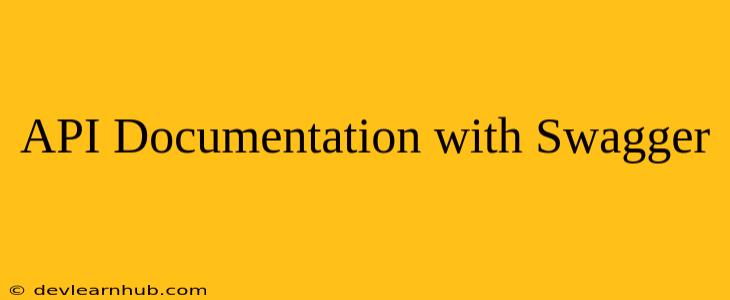Introduction
In the realm of software development, APIs have become the cornerstone of modern applications. They enable seamless communication and data exchange between various systems, fostering a connected and collaborative ecosystem. However, as APIs grow in complexity, effective documentation becomes paramount for developers and consumers alike. This is where Swagger shines, revolutionizing the way we document and interact with APIs.
Swagger, an open-source framework, empowers developers to design, build, and document RESTful APIs in a structured and standardized manner. Its intuitive approach ensures clear and concise documentation, making it effortless for developers to understand and integrate APIs into their projects.
Understanding Swagger and its Benefits
What is Swagger?
Swagger is not just a tool; it's a comprehensive ecosystem for API documentation. It encompasses a range of components that work together harmoniously to create a seamless experience:
- Swagger Editor: A web-based editor that allows developers to define their API specifications using the OpenAPI Specification (OAS).
- Swagger UI: A visually appealing and interactive interface that displays the generated API documentation, making it easy to browse and understand.
- Swagger Codegen: A powerful tool that generates client libraries and server stubs in various programming languages, streamlining the integration process.
Benefits of Using Swagger:
- Standardized Documentation: Swagger adheres to the OpenAPI Specification (OAS), ensuring consistency and clarity across different APIs.
- Interactive Documentation: Swagger UI provides a user-friendly interface for exploring API endpoints, parameters, responses, and examples.
- Code Generation: With Swagger Codegen, you can automatically generate client libraries and server stubs, reducing development time and errors.
- Early Stage Documentation: Swagger encourages developers to document their APIs early in the development cycle, promoting better design and understanding.
- Improved Collaboration: Swagger facilitates seamless communication and collaboration among developers, architects, and testers.
Getting Started with Swagger
Setting up Swagger in Your Project
Swagger integration is straightforward and can be achieved using various methods, depending on your preferred technology stack. Here's a general guide to get you started:
- Choose a Swagger Framework: Select a Swagger framework that aligns with your development environment, such as SpringFox for Spring Boot applications, swagger-php for PHP projects, or swagger-node for Node.js applications.
- Add Dependencies: Include the necessary Swagger framework dependencies in your project's build file (e.g.,
pom.xmlfor Maven orbuild.gradlefor Gradle). - Configure Swagger: Configure the Swagger framework by specifying details like API title, version, contact information, and endpoint definitions.
- Annotate API Endpoints: Annotate your API controllers with Swagger annotations to describe endpoints, parameters, responses, and other relevant information.
- Run Your Application: Start your application, and access the Swagger UI at the specified URL.
Defining Your API with OpenAPI Specification
The OpenAPI Specification (OAS) serves as the foundation for Swagger documentation. It provides a standardized format for describing RESTful APIs, ensuring interoperability and clarity.
Key Elements of OpenAPI Specification:
- Info: Defines metadata about your API, such as title, version, and contact information.
- Paths: Describes the available API endpoints, their HTTP methods (GET, POST, PUT, DELETE), and the parameters they accept.
- Schemas: Defines the data structures used for request and response payloads, ensuring data consistency.
- Responses: Describes the expected responses from each endpoint, including status codes and response content.
Advanced Swagger Features
Customizing Swagger UI
Swagger UI offers extensive customization options to personalize the documentation experience. You can:
- Modify Themes: Apply different themes to enhance the visual appeal of your documentation.
- Add Customizations: Extend Swagger UI with custom CSS and JavaScript to tailor it to your specific needs.
- Integrate with Other Tools: Connect Swagger UI with other tools like CI/CD pipelines or documentation platforms.
Using Swagger for Mock APIs
Swagger can be used to create mock APIs that simulate the behavior of real APIs. This is particularly useful for testing and development purposes.
Generating Client Libraries and Server Stubs
Swagger Codegen allows you to generate client libraries and server stubs in various programming languages. This streamlines integration and reduces the need for manual code writing.
Best Practices for API Documentation with Swagger
- Use Clear and Concise Language: Make sure your documentation is easy to understand and follows a consistent writing style.
- Provide Examples: Include code examples and sample requests and responses to illustrate how the API works.
- Document Error Handling: Clearly document the error codes and messages that your API may return.
- Keep Documentation Up-to-Date: Ensure that your API documentation remains current as your API evolves.
Conclusion
Swagger empowers developers to create comprehensive and intuitive API documentation that facilitates seamless integration and collaboration. By adopting Swagger, you can ensure that your APIs are well-documented, easy to understand, and readily accessible to developers and consumers alike. From standardized documentation to interactive interfaces and code generation, Swagger provides a complete solution for API documentation, ultimately contributing to a more efficient and productive software development process.
